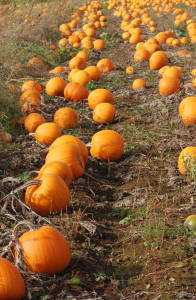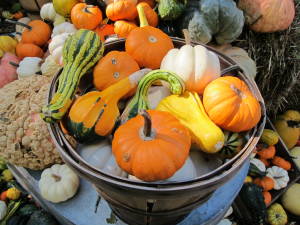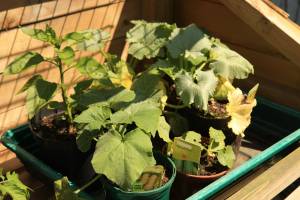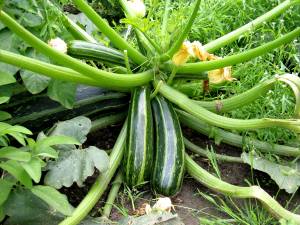Pumpkins are a vegetable frequently grown for size competitions, with some truly gargantuan varieties available. Squash come from the same family, and in some languages of the world there is only one word to describe the two vegetables. Their similarities mean that growing principles are the same for pumpkins and squash, so the guidelines on this page will apply to either.
Varieties of Pumpkin and Squash
The three major groups are curcurbita maxima, cucurbita pepo and cucurbita moschata.
The Maxima group includes large fruits including the traditional large pumpkins and winter squashes, as well as the banana and buttercup, amongst others. They have harder skins and flesh.
The Pepo group includes most summer squashes, including zucchini (otherwise known as courgette), some winter pumpkins that do not keep and some ornamental squashes. They are soft-skinned and can be eaten raw when immature.
The Moschata group includes the very popular butternut, the Kentucky Field and crook-neck squashes. They are large and have a smooth yet tough skin and are particularly resistant to heat.
Planting Pumpkin and Squash
Living in the tropics means that you can grow squash and pumpking year round. As you progress away to drier and cooler climates, the window of time in which to grow pumpkin and squash diminishes. Avoid frosts at all costs (that has a nice ring to it!) The most important factor is soil temperature, so late spring is often the best time to sow in temperate climates.
To grow pumpkins in pots, sow seeds an inch (2.5cm) deep in 3 inch (7.5cm) pots full of a multipurpose compst. Place the pots on a windowsill with plenty of sunlight. The ideal temperature is around 22°C. Once seedlings have formed, transplant them in to 5 inch (12.5cm) pots. The compost in the pots should be kept moist but not soggy.
Before transplanting to the ground, harden off for a week. Sow in the ground at the appropriate time for your climate, planting the seed an inch deep. If the weather is especially wet you could sow a few seeds in to hills of mounded soil. The mounds should be about 2 feet (60cm) apart with 3 feet (90cm) in between rows. Read the packet and speak to your local nursery or growers about specific directions for the variety of pumpkin/squash that you are growing.
Growing Pumpkins and Squash
Pumpkins and squash enjoy a relatively narrow pH range of 5.5 to 6.8. They love water and sustenance in the early stages of growing. A general fertilizer given every fortnight will sustain them well. Do not water directly over the plants to avoid mildew, and try and keep the soil reasonably moist but not soaked, much as when they were grown as seeds. Mulching will help retain moisture and keep weeds down.
How to Grow Large Pumpkins
There are a few things that you need to do to create truly humongous pumpkins. About 8-10 weeks in to growing the first female flowers will form, with tiny pumpkin growths attached. Pick a male flower (thinner stem, no growth), remove the petals and swab the inside of the female flower with the male flower. This will pollinate the flower much earlier in the season than it otherwise would have been by insects, therefore giving the pumpkin more time to grow.

To grow large pumpkins, you need to only allow a few to grow per plant by removing smaller ones as they develop. All of the plant’s energy will be devoted to growing the largest pumpkins.
Be wary during transplantation, too. Any root damage will set back the pumpkins growth.
Growing Pumpkins and Squash in Containers
Small varieties of pumpkin and squash do well in containers. Some examples are summer squash and some zucchinis. Containers should be around 15 inches wide and 15 inches deep (40cm x 40cm). Use potting mix and add organic matter. They can be indoors for a period before needing to spend the rest of the growing period outside. Keep them well watered, as you would if they were in the ground.
Harvesting Pumpkins and Squash
Towards the end of growth, remove foliage from pumpkins and winter squash to allow more sunlight on the fruit. Harvesting time varies but will always be before the first frosts. The ‘time to harvest’ sign is when the foliage starts to die and the skin hardens. Chop them at the stem, leaving a couple of inches attached to the fruit.
Leave them to dry for two weeks outside. A bit of cold weather greatly improves their taste as it increases the sugar content. A bit of frost is okay at this time, but they may need to protected from heavy frosts with straw.
Winter squashes and pumpkins can be stored for around 4 months in a cool and dry environment. Alternatively they can be cooked completely and then frozen. They retain almost all of their flavor using this technique.
Summer squashes are harvested when they are 3-4 inches (7-10cm) long. Marrows are a different story all together – they are grown to full size and ready for harvesting once the skin near the stem is able to be pierced easily by a fingernail. Summer squashes and zucchini last for less time. Zucchini in particular only lasts for about a week in the refrigerator, or it can be frozen by cutting in to slices, blanching for 2 minutes and placing in seal-able freezer bags.
Threats to Pumpkins and Squash
Mildew, both downy and powdery, is reasonably common. Bugs to look out for are ladybirds and beetles.
Cucurbit mosaic causes yellowing and curling of the leaves, and more devastatingly, rotting of the fruit. It’s a virus that is transmitted by aphids, and it ruins the plant. Destroy all plants affected by this virus.



